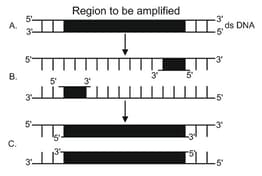Process of Recombinant DNA Technology- Isolation of DNA and its Amplification
Process of Recombinant DNA Technology- Isolation of DNA and its Amplification: Overview
This topic covers concepts, such as Process of Recombinant DNA Technology, Isolation of Genetic Material, Cutting of DNA at Specific Locations, Amplification of Gene of Interest using PCR, Mechanism of PCR, Obtaining the Foreign Gene Product, etc.
Important Questions on Process of Recombinant DNA Technology- Isolation of DNA and its Amplification
Choose the option that is showing the correct sequence of events occurring in each cycle of polymerase chain reaction (PCR).
The source organisms that possess Taq polymerase are
In which of the following technique the bacterium Thermus aquatics is used:
Colonies of recombinant bacteria appear white in contrast to non-recombinant bacteria because of
A well known technique to amplify a small portion of DNA is termed as
Transfer of rDNA through phage is done by
A polymerase chain reaction (PCR) for amplification of DNA fragments involves multiple cycles of thermal denaturation, annealing and extension steps in each cycle. Because of the heat denaturation step, a thermostable polymerase is required for performing PCR. An experimenter had all the resources except the thermostable DNA polymerase to perform a PCR. The experimenter can use _____ to substitute for thermostable DNA polymerase.
The full form of PCR is
Which one among the following primer pairs would amplify the fragment of given below?
Choose the correct sequence of steps in
Identify the chief enzyme that is involved in technique.
Which among the following does not help in early diagnosis?
Microorganisms can be grown in the bioreactors by
PCR technique was developed by ____.
In vitro replication of DNA is called _____.
Stirred Tank Bioreactors (STBRs) are outlined for ______
The process of separation and purification of expressed protein before marketing is called
Which of the following techniques is used to make numerous copies of a specific segment of DNA quickly and accurately?
After products are formed in bioreactors before it is finally released in the market the necessary process which is carried out is
Select the option that correctly identifies steps A, B and C in the figure given below.

